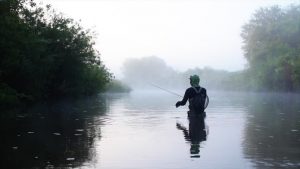 At first glance, a fly line looks simply like a heavy string covered in plastic ??? and techno-speak aside, that is exactly what it is. In most other types of fishing, the lure/bait is what you cast, which is what pulls the line from the reel during the cast.
At first glance, a fly line looks simply like a heavy string covered in plastic ??? and techno-speak aside, that is exactly what it is. In most other types of fishing, the lure/bait is what you cast, which is what pulls the line from the reel during the cast.
While all fly lines work on this principle, there are different styles of fly lines designed for particular applications. And like all things in life, using the right tool for the job makes the whole process a lot smoother.
The following are the three most popular types of fly line:
Level
Level lines are the most basic of all fly lines. They have the same diameter throughout their entire length. They are the least expensive fly lines on the market, however, they are not popular due to their poor performance. For longer casts and more delicate presentations there are line choices that will outperform a level line.
Double Taper
Double-taper lines have been popular for many years. The main advantages of a double-taper line are its more delicate presentation and its reversibility. Since the double-taper line is exactly the same at each end, it can be tied from either end in order to extend its useful life. When one end of the line is tattered and worn, just tie it on from the other end. For fishing small streams where casts are no longer than 30 feet, a double-taper line will work fine.
Weight Forward
Weight-forward lines are the most common lines used today. The first two thirds of the line is a thin-diameter section called running line. The last third of the line widens to a thicker diameter and then tapers to a smaller diameter and is called the belly of the line. With the majority of the line’s weight at the front of the line, it performs more closely to a casting/spinning rod when presenting a lure. There are many different combinations of tapers that are offered in a weight-forward design. Some configurations have longer, thinner front sections, allowing for ultradelicate presentations. Others have short, fat bellies for turning over heavier, more air-resistant flies. If you want only one line for most situations, the weight forward is your best choice.
Sink or Swim
Regardless of style of line (weight forward, double taper or level), the next defining feature among lines is where it rides in (or on) the water column. The three main types are floating, intermediate and sinking.
Floating
Floating lines do what the name implies ??? they float. They are a great choice for an all-around fly line, as the majority of the time anglers will be catching fish on or near the surface. A floating line is the ideal choice for dry flies. A floating line also works well for nymph and streamer fishing when the maximum desired depth is only a few feet.
Intermediate
These lines sink at an extremely slow rate (about 1 inch per second). This is a good all-around lake line for trout when using streamers. It will sink below the chop and is easier to punch through wind while casting because of its more dense composition.
Sinking
Sinking lines are designed to present a fly at a subsurface level. This is usually at a depth that cannot effectively be reached with a floating line and a weighted nymph. Sinking lines are rated as follows:
- Full Sink ??? Full-sink lines come in sink rates from 1.25″ per second up to 9″ per second. These lines work well in deep-water situations such as in a lake or in saltwater. Unfortuantely they can be hard to control, and hard to set the hook due to the excessive drag imparted by the water.
- Sink Tip ??? Sink-tip lines are floating lines with a sinking tip. The tip may vary in length and sink rate. These lines are designed for a variety of subsurface fishing situations. Oftentimes you will use these in lakes and saltwater when you need to get your fly down. They are also used in large, fast, and deep rivers or streams where you need to get your fly into the water but need to stay on top to stay out of obstructions.
Multi-Tip and Specialty Lines
Multi-tip lines are relatively new on the market and may be the best option for the price-minded anglers fishing in a variety of conditions. The lines come with a running section of line and a number of changeable tips. Using the loops on the sections and making a loop-to-loop connection is how you change the tips. These kits come with a floating tip and with multiple sinking tips that sink at different rates.
There are multiple specialty fly lines that target specific species and types of flies. Other specialty lines are designed for specific environments and situations. The two most common environments for which you may need a specialty line are saltwater and cold water. Some lines do not perform well in cold water, as they get stiff. If your fishing takes you to extremes, be sure to get a line that will handle the situation.
Points to remember when buying a fly line:
- Buy the best line you can afford. It is true with fly line, as it is with most other things, that you get what you pay for. All lines can help you catch fish. Better lines will help you be more productive and catch more fish.
- A standard weight-forward line is the best all-around choice for most anglers. If you are looking for one line to do it all ??? a standard weight-forward floating line will suit most of your needs.
- Buy a line that matches your rod. If your rod is rated for two sizes such as a 7-8, it is usually better to get the heavier line. In this case it would be 8-weight line.
Care of Fly Lines
Fly lines will last much longer if a few preventive maintenance steps are taken. For starters, if you are fishing in saltwater, be sure to strip all your fly line and backing into a bucket of freshwater at the day’s end. Flush the bucket several times before rewinding the line on the spool.
When fishing in freshwater this is not necessary. However, in the event that your line picks up sand or dirt, you can use this same procedure to clean it. Depending on how much use the line is getting, use a line cleaner and dressing periodically to keep your line in top performing condition. By following these simple steps, your investment will last substantially longer and will perform better on the water.

